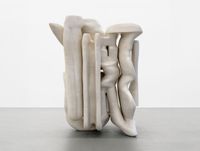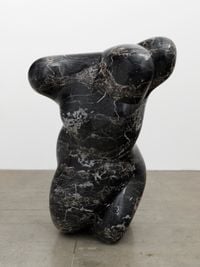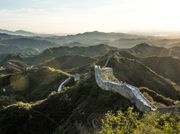British artist Tony Cragg is recognised for his gravity-defying sculptures that explore the relationship between the natural and the artificial.
Read MoreCragg completed his studies at the Wimbledon College of Arts, London (1973) and the Royal College of Art, London (1977).
While initially known for his use of unconventional materials, Cragg has worked with broadly with the more traditional bronze, wood, and steel as well as plastic and found objects. Familiar forms are multiplied, distorted, or warped in Cragg's sculptures, giving rise to expansive or stacked forms that may resemble the human body or natural landscapes.
Cragg garnered attention in the late 1970s and 1980s for his use of found everyday objects and detritus, commonly arranged on the floor or fixed to a wall. For New Stones, Newton's Tones (1978), the artist arranged found plastic objects such as combs, toy shovels, bottle caps and spoons according to colour in a rectangular format on the floor. Similarly using manmade objects to depict natural forms in works such as Leaf (1981) or Bird (1980), Cragg pointed to the impact of human intervention on the world at large.
Cragg has cultivated a tiered appearance to his sculptures throughout his practice. The verticality of his sculptures is sometimes reminiscent of Constantin Brancusi's columns, while the horizontal ellipses that protrude from the columns recall the multi-faceted figures of Umberto Boccioni and Giacomo Balla.
Points of View (2013), a set of three seven-metre columns, seems to change shape when viewed from different angles. Unlike the artist's earlier works such as Minster (1990)—which consists of four sculptural forms but is made of circular metal machine parts amassed into towers—sculptures like Points of View are often in one solid piece, but retain a stacked illusion through their horizontal extensions.
For the series 'Early Forms' and 'Relational Beings', Cragg employs more traditional media to examine sculpture's potential to transform the familiar into something new and unusual.
'Early Forms', begun in the late 1980s, is inspired by the vessel, one of the earliest objects made by humankind, that the artist distorts and twists to create new forms. In the bronze Taurus (Early Forms) (1999), for example, the original vessel is unrecognisable in the monumental bronze sculpture whose smooth planes and curvature instead recall oysters or the waves of the sea.
By contrast, the later series 'Rational Beings' is concerned with the transformation of the human figure into abstraction. For the wooden sculpture A Head, I Thought (2011), Cragg contorted a facial profile until it became a new form of abstracted columns and slabs.
Cragg has been recognised for his prolific practice from the early days of his career. He was the winner of the Turner Prize in 1988 and, in that same year, represented Britain at the 43rd Venice Biennale. In 2002 he was made a Commander of the Most Excellent Order of the British Empire for service to the visual arts and Anglo-German relations. Cragg has also worked as an educator, teaching at Ecole Nationale Supérieure des Beaux-Arts, Paris (1999–2009) and at the Kunstakademie Düsseldorf (2009–ongoing).
A regular presence in international galleries and museums since the late 1970s, Crag has shown his work in numerous solo and group exhibitions.
Solo exhibitions include: Riot, Lisson Gallery, New York (2023); Incidents, Marian Goodman Gallery, New York (2022); Tony Cragg - Sculptures, Buchmann Galerie, Berlin (2021); Rare Species, Brazilian Museum of Culture and Ecology, São Paulo (2019); Anthony Cragg: Human Nature, Istanbul Modern, Istanbul (2018).
Group exhibitions include: Keramik, Buchmann Galerie, Berlin (2023); The Privilege of Painting—20th Century, SETAREH, Düsseldorf; Spectrum, Lisson Gallery, New York (2020); Beyond Borders, Boghossian Foundation, Brussels (2018); Economic values / museum values, Kunsthalle Düsseldorf (2017).
Tony Cragg's website can be found here.
Sherry Paik | Ocula | 2023







